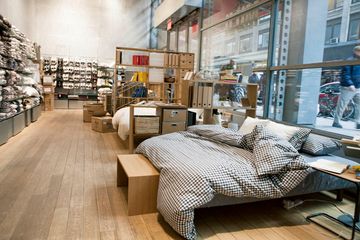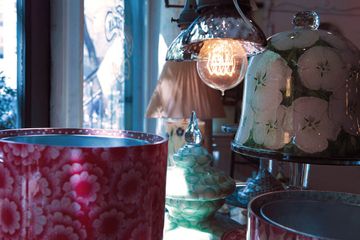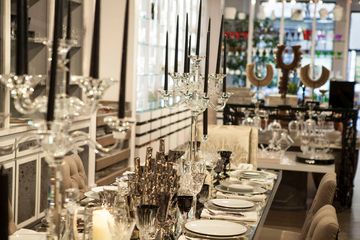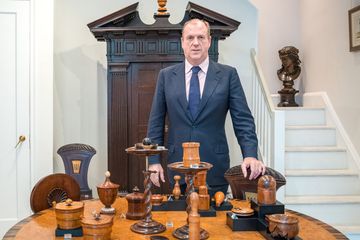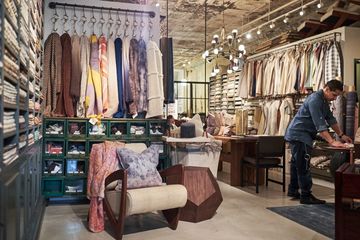Angus Wilkie, who describes the location of his semi-hidden gallery, Cove Landing, as "squirreled away on 74th Street, " is no newcomer to the art world. His career had an unexpected beginning: whereas many people hope to one day have a gallery of their own, Angus started with an eponymous gallery on Grand Street. He showed me an artistic photograph of himself as a younger man, gazing out from behind the windows of his gallery with a large dog on the doorstep. During this time, he wrote a book on Biedermeier furniture. This book was part of the reason why he then got a job at Christie's for ten years in the European Furniture Department. Angus told me that his time at the famous auction house allowed him to "sharpen [his] teeth and work on other things. " He continued writing, penning a number of articles on decorative art. He knew, however, that he would one day return to having his own gallery. "I always wanted to be a dealer, " he shared. "Being a dealer is in my blood, somehow. "In 1997, Angus and his partner, architect Len Morgan, bought a building in Lyme, CT, and began renovating it. The town called the old building "Cove Landing, " which Angus decided was a perfect name for a gallery. In 2000, he opened Cove Landing (the art gallery) on Lexington Avenue. In 2013, he moved to 74th Street. Angus claims that most of his knowledge of furniture was learned through osmosis. "It's like learning a language, " he explained. It takes years of looking at different pieces to discover what they are saying - the little signs that furniture shows and the signals that the trained eye can pick up - and then share with a customer. In the anthropomorphic world of furniture, Angus is a true anthropologist. "I have a weird dialogue with objects... they reveal a real character and story to me. " Despite crediting his knowledge to his experience, it quickly became apparent that Angus was an avid reader, and seemed to have the learning of a true academic in addition to the skills gained through many years in the field. He told me stories of exhaustively researching different topics, both for his business and his own curiosity. "I love to know the history of materials, " he said with a smile. For example, he showed me a 1920s box made of shagreen, a material that comes from stingray skin. He was eager to know "What's the story of shagreen? " By reading everything he could get his hands on, Angus discovered that the first mention of shagreen came from the eighteenth century, when Turks would use it on weaponry. It then reached its heyday in the 1920s when Jean Michel Frank, the French interior designer, brought it into style - hence the origin of the box. Angus then wrote an article on the substance. His love of materials is obvious in his collections. Angus showed me around his October 2015 exhibition, called "Treen, " an old English word that means "made of tree. " The gallery was filled with utilitarian items such as snuff boxes, butter tubs, and other functional tools, all made from one piece of wood with no joinery. Some objects' purposes were obvious, while others were more enigmatic. There was an eighteenth century "priest, " a wooden mallet used for hitting fish on the head in order to kill them swiftly. My eye was caught by a beautiful piece that Angus informed me was an Anglo-Indian turban stand, as well as a clever folding swift for winding wool. "I like things that are slightly mechanical, " he commented. The last show at Cove Landing had been cheekily titled "Stoned, " and included work in marble, hard stones, and other geological materials. Although Angus does not get as much footfall on a side street, he relishes the opportunity that the space gives him to create more curated shows. He sends out beautiful cards to his followers for each new exhibit, which then leads to a "captive audience" of Treen collectors, or people who are simply curious about what the gallery is displaying in the next exhibit. Angus appreciates the fact that since the space is truly a little apartment, clients can see how the pieces look in a home setting. The main objective, however, is to sell the furniture underneath the decorative objects. He assured me that the way his gallery was currently set up, with curious Treen covering most surfaces, was not usual. "It is incredibly crowded in here, " he said with a slight frown. "I usually like a very spare, edited look. It is purposefully zen and open. " Despite Angus' disclaimers, I felt a sense of calm. Everything was arranged in a way that best displayed Angus' love, in his own words, of "silhouette of form. "
